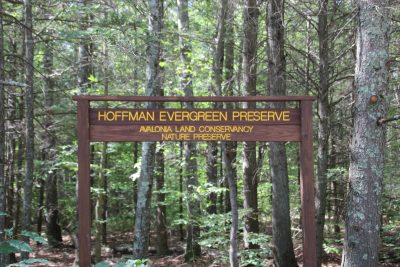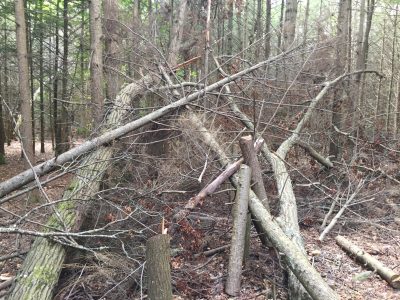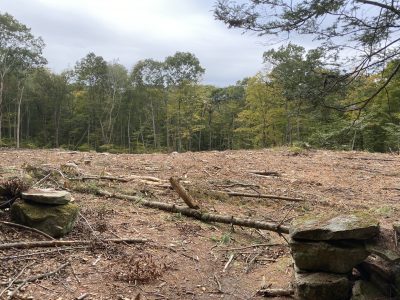
By Judy Benson
Stonington – Battered by coastal storms and infestations of wooly adelgids, gypsy moth, winter moth and emerald ash borer, sections of the 200-acre Hoffman Evergreen Preserve will now serve as a living lab and demonstration site for how land managers can help forests adapt to climate change.
“We want to increase the resilience of the forest and maintain the water quality filtration services it provides to Long Island Sound,” said Juliana Barrett, coastal habitat specialist for Connecticut Sea Grant. “We’re trying to plant the right trees for the right time.”
Owned by the Avalonia Land Conservancy and popular with hikers and bird watchers, sections of the forest became unsafe over the last decade due to large numbers of diseased and storm-damaged trees. That prompted the land trust to contract with Hull Forest Products to do selective logging in 2019 that left open areas that will now be the subject of a joint project between Avalonia and CT Sea Grant.
“This is about helping to restore a healthy forest,” said Beth Sullivan, Stonington chairperson for Avalonia. “It’s something we’ve been working towards for the last five to six years.”
A grant of $57,144 from the Long Island Sound Futures Fund, announced last week, will provide funds for the development of a unique forward-looking forest management plan for the cleared areas, along with a series of public education programs. Barrett said the project is one of the first of its kind in Connecticut that incorporates climate change projections and assisted migration techniques for plants better adapted to future conditions. Some seedlings and seeds will be planted as part of the yearlong project, chosen both for their ability to regenerate under future climate conditions and their value as food sources for wildlife. Robert Ricard, a forester and senior extension educator with UConn, will help develop the plan and planting list, and provide guidance on the best locations for particular species.
“We’re going to try some species at the edge of their limits in Connecticut that, based on climate change projections, we think will do well,” Barrett said.

Instead of replanting the same species of hemlocks, oaks and ash shown to be vulnerable to the pests and weather disruptions brought by climate change, the plan will identify tree and shrub species likely to be more resilient in warmer temperatures. These could include loblolly pine, tulip poplar, sweetgum and others more common in the mid-Atlantic region. About a dozen loblolly pine seedlings planted last spring, in fact, have already become well established despite last summer’s drought, Sullivan said.
The preserve, located at the north end of town several miles from the shoreline, nonetheless provides important services to Long Island Sound by absorbing runoff and filtering pollutants that would end up in the estuary, Barrett noted.
The public education component was developed with Avalonia project collaborator Sharon Lynch, George Washington University professor emerita in the School of Education and Human Development. An expert in science teacher education, Lynch currently works on education initiatives with the National Science Foundation. The education component will consist of a series of four webinars on topics relevant to the project, including the history of New England forests and the carbon sequestration services they provide. The series is intended for municipal officials, land trust officials, forest landowners and the general public. In addition, a two-day workshop on guiding principles for coastal forest resilience in the Long Island Sound region will be offered specifically for municipal officials, resource managers, land trust officials, forest landowners and students. An accompanying fact sheet will be developed and published.
Nancy Balcom, CT Sea Grant associate director of CT Sea Grant, said she hopes the project will provide valuable information for land managers throughout the region.
“Given the devastation our local forests have suffered which threatens their ability to provide critical ecosystem and recreational services, it’s important to not only test the ability of new species to survive and thrive in our changing climate but to also share the progress and results widely so other land trusts and organizations can pursue similar paths,” she said.

Barrett said the lessons learned at the Hoffman preserve will be shared with other land trusts and land managers, and hopes that tours of the site can be offered in the future to show how different plant species are adapting. The project, she said, will be an opportunity “to educate and engage land trust stewards, resource managers, municipal officials and neighbors in understanding coastal forest ecosystem services, impacts of climate change on these systems and guiding principles for management under changing conditions.”
The grant for the Hoffman Preserve, which will be matched with $33,600 in in-kind services from Avalonia volunteers, is one of 38 awarded in this year’s Long Island Sound Futures Fund program. The 15-year-old program combines funds from the U.S. Environmental Protection Agency, the U.S. Fish and Wildlife Service and the National Fish and Wildlife Foundation to support projects that improve the water quality and restore habitat in the Long Island Sound watershed. This year, $3.8 million in funding will support 15 projects in Connecticut, 14 in New York, three in Massachusetts, three in Vermont, one in New Hampshire and two in multiple states.
“It is heartwarming to see innovation at work, people and organizations getting together, planning and acting now for what the world will look like in decades,” said Sylvain De Guise, director of CT Sea Grant. “At the same time, it is encouraging that grant programs are open enough to recognize and fund innovation, even if riskier than sticking with old habits.
“I think we are heading in the right direction,” he concluded.
Also read about the project in the UConn Today article, “UConn Researchers Developing Coastal Forest Resiliency Plan for Coastal Evergreen Preserve.”
Judy Benson is the communications coordinator for Connecticut Sea Grant.